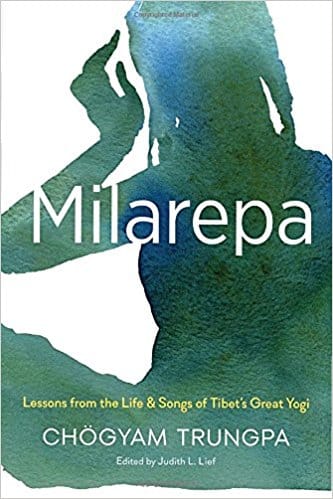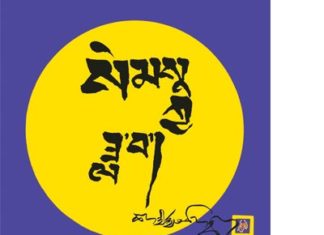
In days not so far ago, during the late1960’s and early 1970’s, there were very few books on Tibetan Buddhism available in English, not even enough to fill a single shelf in a bookstore. One of the most prominent was the two-volume set The Hundred Thousand Songs of Milarepa, translated by Garma C.C. Chang. Another was the biography of Milarepa edited by Evans-Wentz. The stories and songs in these volumes unfolded the teachings of Vajrayana Buddhism not in philosophical discourse nor abstract academic characterizations, but in highly personal and utterly human experience. The life and songs of Milarepa continue to stand as the epitome of what the spiritual path actually looks like in real life, and demonstrates the entire path in the vivid realities of Milarepa’s life. Milarepa’s life and example have for centuries stood as the paradigm of spiritual endeavor for Tibetans, and now for the West.
In 1963, the direct spiritual lineage and mind of Milarepa showed up in person in the West. Chogyam Trungpa Rinpoche stepped onto Western soil as though Milarepa himself had just walked out of his meditation cave directly into the busy modern world. And indeed this collection of seminars on the life and songs of Milarepa by Trungpa Rinpoche, originally given in the first few years of his teaching in the United States, between 1970 and 1976, is Milarepa’s own mind and voice. It is Milarepa’s mind and voice, after all, that is the inheritance and successive realization of the Kagyu lineage of mahamudra.
Edited by longtime Trungpa Rinpoche editor Judy Lief, Milarepa is divided into two sections. Part One, Milarepa and the Mahamudra Tradition, describes Milarepa’s life, starting with a tumultuous youth following the death of his father and the severe mistreatment of his mother and himself by greedy and ruthless relatives. Milarepa takes murderous revenge using black magic, but soon regrets his own pernicious deeds. He then seeks a guru to set him on the way of reversing the inevitable dire consequences of his dark past. He finds Marpa. Thus begins his long life (he died at the age of 83) of trials, service to his guru, bravery in facing his own mind and life with “genuineness and honesty” in the most direct light of meditation during years of practice in solitude, and his eventual spiritual victory and realization. He spends the rest of his life teaching the most profound insights of his realization in exquisite songs, arising spontaneously in response to whatever situation presents itself. And in the ordinary immediate and highly accessible language of everyday life, not the specialized religious language of doctrinal Buddhism.
Trungpa Rinpoche parallels the events in Milarepa’s life with teachings on the basic and unavoidable challenges and raw truths that any practitioner of the spiritual path inevitably encounters. He chronicles the deceptions and side tracks that Milarepa trips over, the hardships of enduring what are, to begin with exceedingly difficult conditions in service to his guru and in retreat, and perhaps above all, his unrelenting devotion to his teacher and the path. That devotion is the key to the Vajrayana path and realization. Milarepa’s life demonstrates the origins of the spiritual path in despair and crisis, then its continuation through sustained non-theistic (beyond hope and fear) discipline, what the book coins as “positive pride and the celebration of devotion and discipline”. And all along the way, the undoing of deception, “exposing ego’s dirty tricks” and overcoming spiritual materialism.
Some of Trungpa Rinpoche’s observations take a surprising turn. For instance, whereas one might think that Milarepa’s main experience of loneliness and desolation occurred during his years in solitary retreat, Trungpa Rinpoche suggests that his most penetrating desolation came with his return to his home after some time, and observing the ruins of his past, even finding the skeleton of his mother in the now abandoned house of his youth. Beyond this, he endured the beatings of his aunt, who, having discovered his return, came to extract her own revenge.
Or consider Milarepa’s relationship with his guru Marpa. After enduring severe hardships while obeying Marpa’s command to build a tower, then to tear it down and start over several times, Milarepa finally, on the verge of suicide, is entered into Marpa’s teaching circle. These ordeals have purified him of the dismal karma accumulated in his earlier years. But after some time, he is again turned out, this time to take up a life of solitude in the vast inhospitable wilderness of Tibet. Trungpa Rinpoche indicates that an essential aspect of the guru-student relationship is, then, at some point to leave one’s guru and the potentially deceptive coziness of a close relationship with him or her, in order to uncover the inner guru of one’s own mind and Buddha Nature.
Trungpa Rinpoche characterizes Milarepa’s desolation in retreat as having become “spiritual romanticism” arising out of sadness and loneliness, and characterized Milarepa’s early retreat songs as “love songs”. He then later devotes a section to Milarepa’s love and compassion, emphasizing the word love as being more to the point in Vajrayana. I recall myself having gone on my first retreat many years ago in a very remote abandoned old miner’s cabin on the upper slopes of the Continental Divide in Colorado. At first highly inspired and enthused by the example of Milarepa, I imagined spiritual revelations such as Milarepa’s would come gushing forth. After very few days, instead, I was appalled at the harshness of both the locale and my own relentlessly chattering mind, accompanied by the irritation of mice constantly scurrying across my shrine and eating my food. I left the retreat prematurely, disgusted and disillusioned. A few days later, in a private interview with Trungpa Rinpoche, I complained to him about the harshness and lack of warmth and romanticism of Milarepa’s approach. Trungpa Rinpoche replied to me that on the contrary, Milarepa was highly romantic, the most romantic of all. But that unlike conventional romanticism that is based in fantasy about the past or future, Milarepa’s romanticism was that of the present moment.
Trungpa Rinpoche writes, “At the beginning of retreat, you were irritated by the insects around you, but you begin to wish you could invite them in for a party or for dinner. You begin to feel appreciation. A subtle romanticism is happening completely due to the experience of there being nothing to entertain yourself with, so that everything comes back to you.”… “It is a very subtle love affair, but it is definitely romantic.”
The first section ends with a brilliant capsulation of the Four Yogas of Mahamudra teachings, and the book later clarifies the often misunderstood yogic practices that accomplish them (such as tummo, the practice of inner heat). It also elucidates the basic features and functions of Buddhist yogic disciplines, which Milarepa mastered so completely and passed down to us.
Section Two, Songs and Commentaries, consists of Trungpa Rinpoche’s own translations of a selection of Milarepa’s songs, accompanied by his commentary on their significance as direct spiritual instruction.
One of the more famous of the songs is The Challenge of the Logicians, which recounts a visit to Milarepa by a few highly intellectual and arrogant Buddhist scholars, who seek to expose Milarepa as a stupid imposter.
But Milarepa instead exposes their own hypocrisies and lack of real experience, using the intelligence of the interchange in a way that far surpasses the scholar’s abstracted attacks. Trungpa Rinpoche brilliantly distinguishes the logic of direct experience from the hollowness of fabricated intellectualized logic.
Rechungpa was Milarepa’s adopted son, whom he trained in meditation from a young age. He was, perhaps, the closest person to Milarepa. Yet in the commentary on Milarepa’s song Rechungpa’s Repentance, occurring later on in Rechungpa’s life, Trungpa Rinpoche demonstrates how perniciously the demons of arrogance and self-importance can creep into even the most lovingly groomed and gifted spiritual personality, and derail one from those most primary of spiritual qualities, humility, and egolessness.
The other principal student of Milarepa was Gampopa, who connects with Milarepa after a very full domestic then monastic life. Trungpa Rinpoche presents a fascinating comparison of Rechungpa and Gampopa, citing the workability and ability of Gampopa to go straight to the core of Milarepa’s instructions due to his already ripened worldly and spiritual experiences and insights. Trungpa Rinpoche identifies the talent Gampopa had for relating to “auspicious coincidence” in his meeting with Milarepa, and the importance of being able to tune into auspicious coincidence in any situation, by entering fully into the situation.
The book follows Milarepa’s life through to his breakthrough, enlightenment, and subsequent buddha activity and teaching. Rather than leave his remote mountain retreat, the world comes to Milarepa. His continuing spiritual life, then, resolves completely around his encounters with others, as his skillful means and compassion become more and more immediate and spontaneous.
In an eloquent expression of the central Vajrayana attitude and practice of dag nang, pure perception or sacred outlook, Trungpa observes “The vajrayana view, Milarepa’s view of reality, was that everything is regarded as a breakthrough. He did not regard anything as cursed or distorted: everything could be included in the practice itself.”
Instrumental in all this is Milarepa’s injunction that “in the space between two thoughts is a moment of thought-free wakefulness.” Trungpa Rinpoche, in his commentary on the song Salé Ö and Her Understanding, renders this famous pith instruction into a vivid discussion of the essential experience of gap in meditation and everyday life, and in death. “…The particular moment when this gap occurs is the ultimate state.”
In the commentary on The Songs of Realization, Milarepa then Trungpa Rinpoche strike to the core of mahamudra realization, from “transcending samsara and nirvana”, to the “meeting of external and internal conditions” as the realization of the internal guru, to crazy wisdom… “as there were more questions, his (Milarepa’s) answers became more precise and sharp, and more maddening in a sense.”
Trungpa Rinpoche’s commentary on the song Milarepa’s Song of Craziness delves further into the breakthrough of crazy wisdom. “The question of madness (the higher level of madness) is, do we actually want to twist our life in an entirely different angle? Are we willing to be free?” As Milarepa summarizes in a burst of vajra pride:
“In order to explain this crazy way of craziness:
The fathers are crazy, the children are crazy and the lineage is crazy.
The source of the lineage, great Vajradhara, is crazy.
Great grandfather Tilo Prajnabhadra is crazy.
Grandfather Naro mahapandita is crazy.
Old father Marpa the Translator is crazy.
I, Milarepa, am crazy.”
Appropriate, perhaps, to Trungpa Rinpoche’s own predilections, the book’s next to the last chapter is on The Beer Drinking Song, which parallels the brewing and drinking of beer with the spiritual path and its realizations. “This chang (beer) is the drink of the lineage. If anyone drinks this lineage drink, inner joy blazes out…” The chapter details how to and how not to drink this intoxicating elixir of spiritual illumination. “It seems that this kind of intoxication symbolism has tremendous meaning: it is that which brings you into a state of precision and abruptness as well as inspiration.”
And finally, the book ends with Farewell to Holy Gampopa. In this song, perhaps one of the simplest and yet most profound of Milarepa’s spiritual instructions, Milarepa calls the departing Gampopa back, knowing this will be their last meeting, to impart the most precious teaching of all. Milarepa then bares his ass, which has become totally calloused from years of sitting meditation practice. This vivid demonstration of perseverance and patience, then, is his last statement to the next holder of the lineage. And his message to all later generations of practitioners.
These are only a few observations from this very profuse and rich book. This collection deserves to be digested in a measured way, not simply as stories, historical literature, or spiritual folklore. It is best served up with a healthy portion of meditation practice. But it also stands on its own as a testament and guidebook on how to live a human life to its fullest, not in spite of obstacles, fears, and set-backs, but because of them. Each person will identify with appreciate different songs. It is a great book to take on retreat, along with the Hundred Thousand Songs of Milarepa. Or as a superb use of insomniac hours when the night is as still and undisturbed as Milarepa’s meditation cave. Or, you could pick it up right now, flip randomly to a page, and probably encounter something of immediate value for your life, straight from the mouth of Milarepa.
Some may think that Milarepa and his yogic lifestyle is a relic from a bygone era in Tibet. But this collection of teachings on his life and songs from one of his direct spiritual heirs, Trungpa Rinpoche, proves that every aspect of Milarepas journey is utterly relevant and applicable to today’s world. As Trungpa Rinpoche once said, “Dharma is always up to date.
















